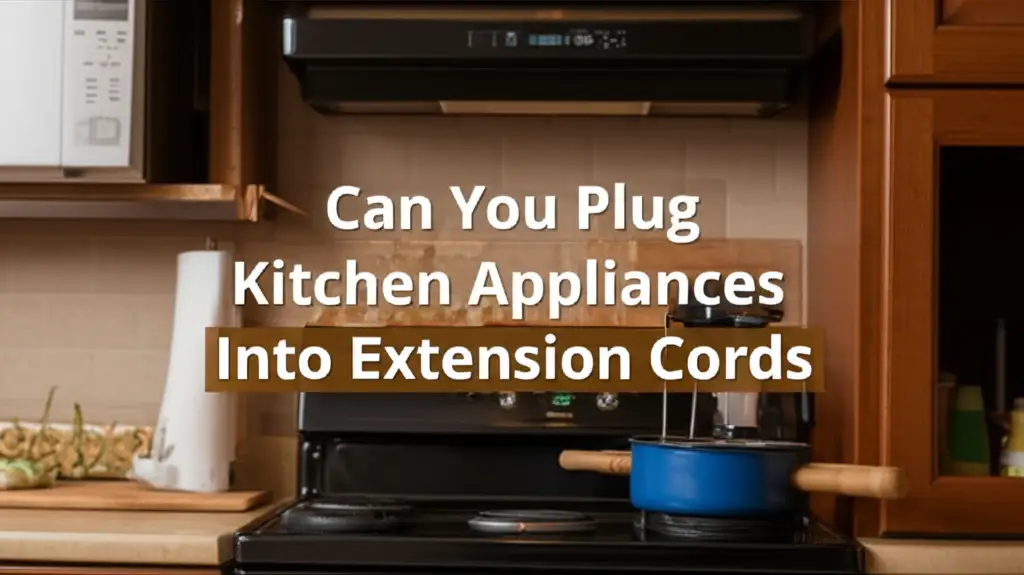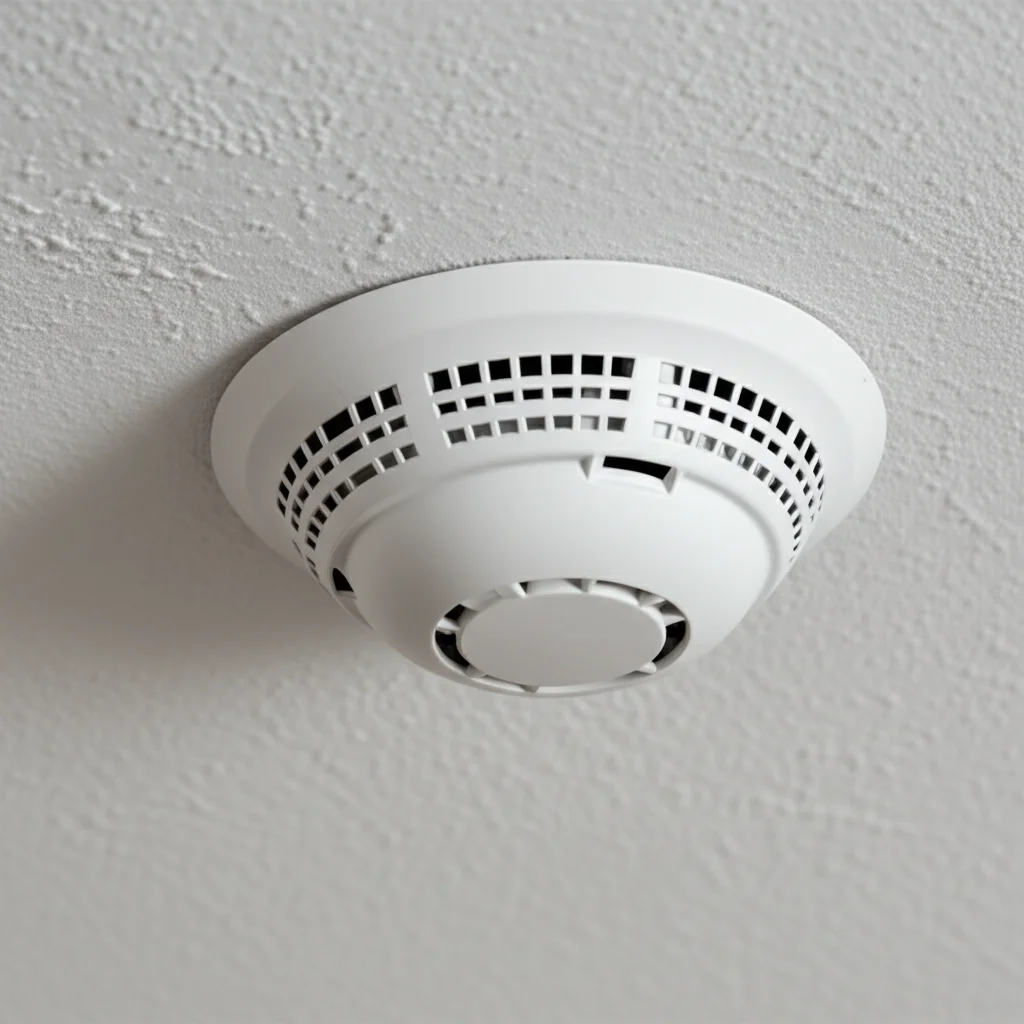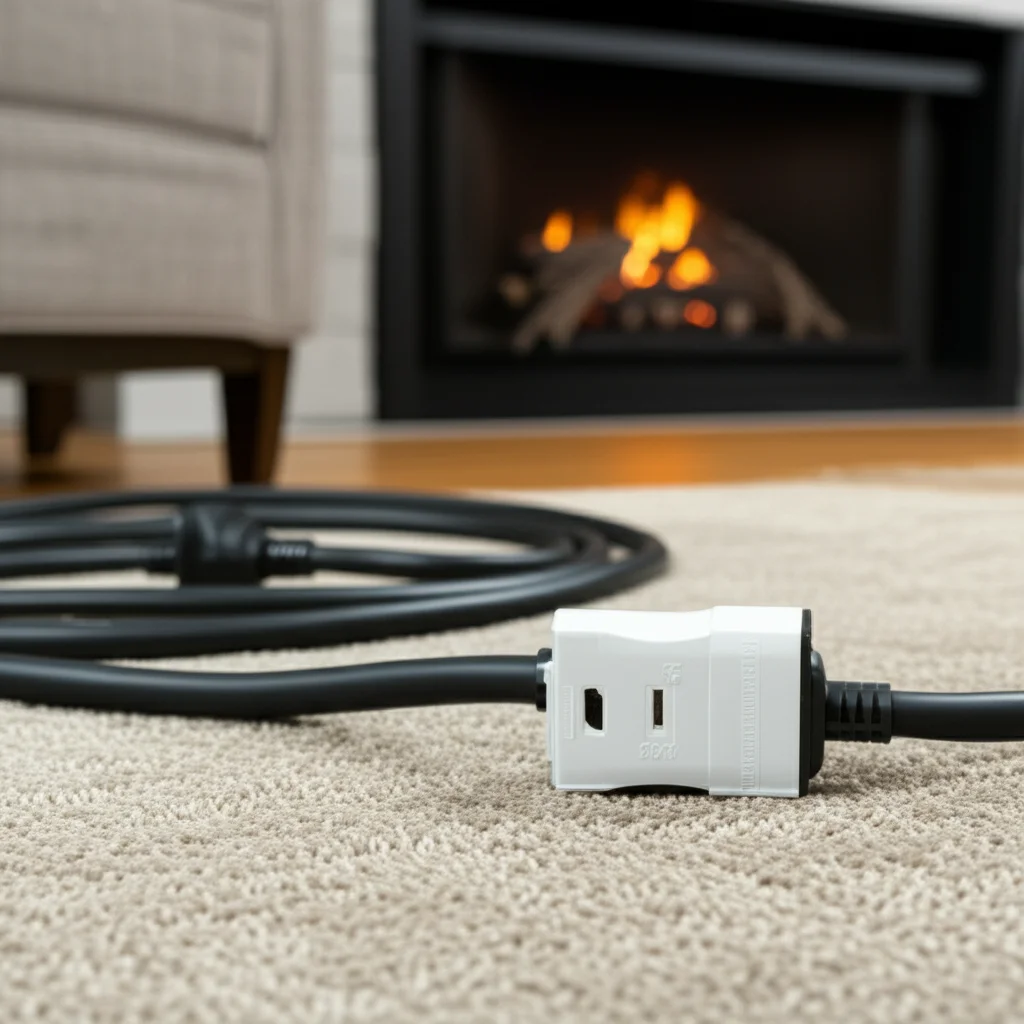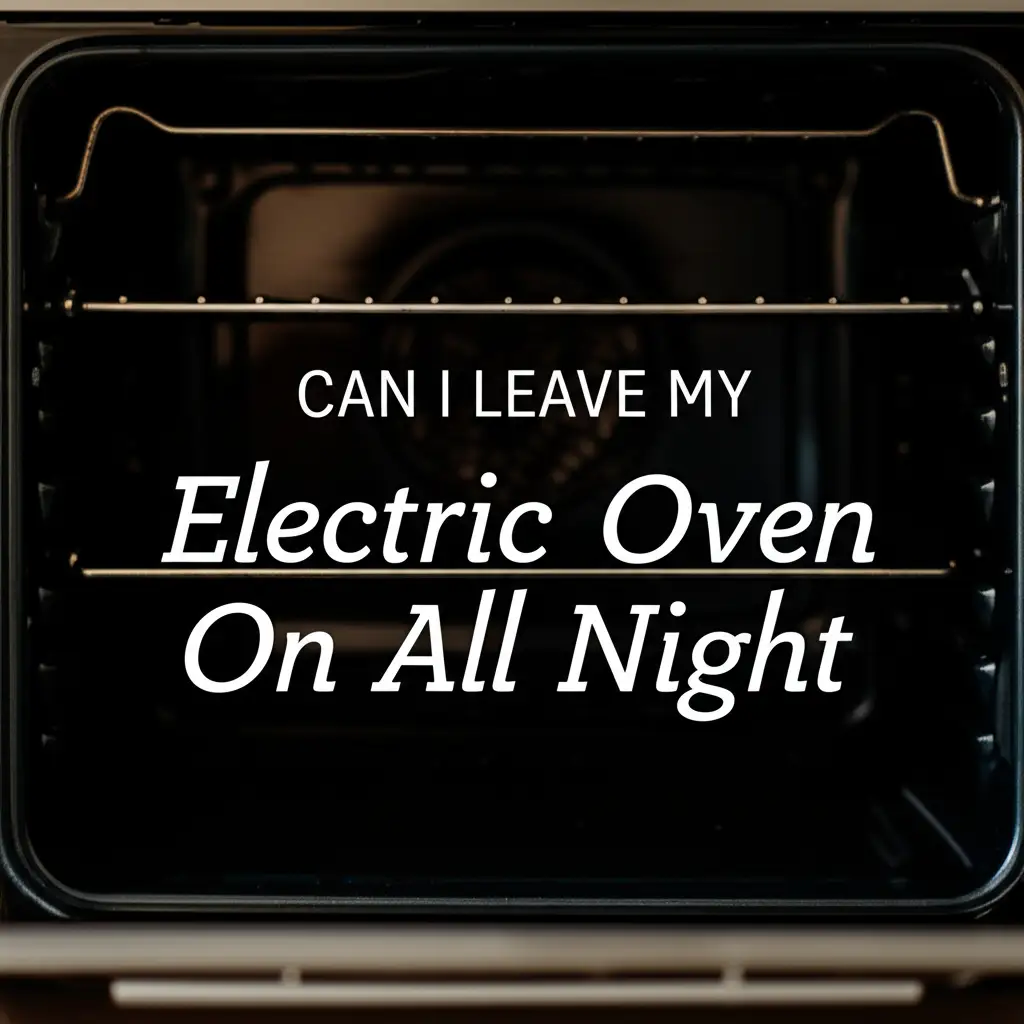· Todd Martin · Home Safety · 18 min read
Can You Plug Kitchen Appliances Into Extension Cords

Plugging Kitchen Appliances into Extension Cords: Safety First
We all seek convenience in our homes. Often, this desire leads us to look for power solutions when outlets are not close enough. Plugging kitchen appliances into extension cords might seem like a simple answer to a common problem. However, this common practice carries significant risks if you do not understand the underlying electrical principles. Safety should always be your top priority when dealing with electricity in your home.
This guide will explain when it is safe, and more importantly, when it is unsafe, to use extension cords with your kitchen appliances. We will cover the different types of extension cords, the hazards involved, and how to make informed decisions. My goal is to equip you with the knowledge to protect yourself and your family from potential electrical dangers. You will learn about safe practices and essential tips for managing power in your kitchen.
Takeaway
- Avoid using extension cords for high-wattage kitchen appliances. Appliances like refrigerators, toasters, microwaves, and coffeemakers draw significant power. Plugging them into extension cords can cause overheating, leading to fires or electrical damage.
- Match the extension cord’s power rating to the appliance’s needs. Always check the wattage or amperage rating on both the appliance and the cord. The cord’s rating must meet or exceed the appliance’s requirements to prevent overloading.
- Use extension cords only as a temporary solution. Extension cords are not for permanent wiring. Relying on them for daily use poses a continuous safety risk.
- Never hide extension cords under rugs or behind furniture. This practice traps heat, prevents proper cooling, and can damage the cord, creating a fire hazard.
- Inspect cords regularly for damage. Look for frayed wires, cracked insulation, or loose plugs. Replace any damaged cord immediately to prevent electric shock or fire.
Is It Safe to Plug Kitchen Appliances Into Extension Cords?
Generally, it is not recommended to plug kitchen appliances, especially high-wattage ones, into extension cords. While some low-power appliances might tolerate short-term use with a properly rated cord, large appliances demand direct wall outlet connections due to their power consumption. Improper use can cause serious fire and electrical hazards.
Understanding Appliance Power Needs and Extension Cord Basics
Every electrical appliance has specific power requirements. These requirements tell you how much electricity the appliance uses to operate. Understanding these needs is key to safely powering your devices. Kitchen appliances often have higher wattage ratings compared to other household items.
Extension cords are not all the same. They come in different gauges, which refers to the thickness of the wire inside. A smaller gauge number indicates a thicker wire, allowing it to carry more current safely. Using the wrong cord can cause big problems. We must match the cord to the appliance’s needs.
What is Appliance Wattage?
Appliance wattage measures how much power an appliance consumes. You can usually find this number on a label or sticker on the appliance itself. For instance, a microwave oven might use 1000-1500 watts. A toaster can use 800-1500 watts.
High-wattage appliances generate a lot of heat during operation. This heat must dissipate safely. If an extension cord cannot handle the current, it will overheat too. This overheating creates a fire risk. Always check the wattage before plugging anything in.
Choosing the Right Extension Cord
Selecting the correct extension cord is vital for safety. Look for the cord’s amperage (amps) or wattage rating. This rating tells you the maximum power the cord can safely carry. The cord’s rating must always be higher than the appliance’s rating.
For example, if your appliance is 1500 watts, use a cord rated for at least 15 amps (since watts = volts x amps, and standard home voltage is 120V, 15 amps x 120V = 1800 watts). Thicker cords (smaller gauge numbers) can handle more power. Using a cord that is too thin will cause it to overheat.
High-Wattage Kitchen Appliances: Avoid Extension Cords
Certain kitchen appliances draw a significant amount of electrical power. These are typically appliances that heat things up or have powerful motors. Plugging these high-wattage devices into extension cords creates a serious fire hazard. The cord can overheat, melt, or even ignite.
I always advise against using extension cords for these types of appliances. They need to be plugged directly into a wall outlet. Wall outlets are designed to handle the electrical load safely. Extension cords are only for temporary use with low-power items.
Common High-Wattage Culprits
Many popular kitchen items fall into this high-wattage category. They are essential for cooking and food preparation. However, they are also significant fire risks if powered incorrectly.
Here is a list of appliances you should almost never plug into an extension cord:
- Microwave Ovens: Microwaves use a lot of power to cook food quickly. They can overload many standard extension cords.
- Toasters and Toaster Ovens: These appliances produce intense heat in a short time. An extension cord might not handle the sudden power surge.
- Coffee Makers: Even though they seem simple, coffee makers heat water, which demands considerable power.
- Electric Kettles: Similar to coffee makers, electric kettles rapidly boil water, requiring high wattage.
- Blenders (High-Power Models): Strong blenders, especially those designed for crushing ice, use powerful motors that draw a lot of current.
- Slow Cookers and Instapots: These appliances operate for long periods, generating continuous heat. This sustained use can cause an extension cord to overheat.
- Refrigerators and Freezers: These are always on. They have surge currents when the compressor starts. Plugging them into an extension cord can damage the appliance’s motor or cause the cord to melt.
- Electric Ranges and Ovens: These are extremely high-wattage appliances. They require dedicated circuits and special outlets. Can you plug electric oven into normal socket is an important question to understand for electrical safety.
For any appliance that heats up or has a large motor, a direct wall connection is the safest option. Do not risk your home’s safety for the sake of convenience.
Low-Wattage Kitchen Appliances: When Extension Cords Might Be Okay
While high-wattage appliances are a definite no-go for extension cords, some smaller, low-power kitchen gadgets might be acceptable for temporary use. However, even with these, caution is important. The key is to understand the appliance’s power draw and the cord’s capacity. Always prioritize safety over convenience.
I suggest using a very short, heavy-duty extension cord for these instances. Long, thin cords increase resistance and heat buildup. Ensure the cord is in perfect condition and never run it under rugs or through doorways where it can be damaged. Remember, “temporary” means for a specific task, not permanent daily use.
Examples of Low-Wattage Appliances
Some kitchen appliances use minimal power. These might be suitable for an extension cord, provided it’s a short, heavy-duty cord used temporarily. They do not generate significant heat or have powerful motors.
Here are a few examples:
- Electric Can Openers: These typically have very low power consumption. They only operate for short bursts.
- Hand Mixers (Low-Speed Settings): While some hand mixers can draw a bit more power at high speeds, they are generally low-wattage.
- Small Food Scales: These use minimal power, often running on batteries or a very low-power adapter.
- Phone Chargers or Tablet Chargers (for kitchen use): If you are charging a device in the kitchen, these draw little power.
- Electric Knives: Used for short durations, their power draw is usually low.
Even with these, check the appliance’s wattage. If you are unsure, err on the side of caution and plug it directly into a wall outlet. Using a properly rated extension cord for temporary tasks is acceptable, but prolonged or daily use is still not ideal.
Dangers and Risks of Improper Extension Cord Use
Using extension cords incorrectly in the kitchen presents several severe hazards. These risks range from minor inconveniences to life-threatening situations. Understanding these dangers can help you make safer choices. My personal experience has shown me how quickly electrical issues can escalate. Always treat electricity with respect.
The most common risks involve overheating and electrical shock. These can lead to significant property damage or personal injury. Never underestimate the power of an overloaded circuit or a damaged cord.
Overheating and Fire Hazards
The primary danger of using extension cords, especially with high-wattage appliances, is overheating. When an extension cord carries more electricity than it is designed for, the wires inside heat up. This heat can melt the cord’s insulation, expose live wires, or even ignite nearby flammable materials.
Signs of overheating include:
- Warm or hot cord: The cord feels warm to the touch. This means it is struggling to handle the load.
- Burning smell: A distinct smell of burning plastic or rubber indicates melting insulation.
- Discoloration: The cord or plug ends may show scorch marks or discoloration.
If you notice any of these signs, unplug the appliance immediately. Replace the cord and assess the wall outlet for damage. Overloaded extension cords are a leading cause of residential fires.
Electrical Shock and Electrocution
Damaged extension cords or improper connections can lead to electrical shock. If the insulation frays or cracks, live wires can become exposed. Touching these wires can cause a painful and potentially fatal electrical shock. Water in a kitchen environment increases this risk.
Never use an extension cord that shows signs of wear or damage. Keep cords away from sinks, water pipes, and wet areas. Ensure your hands are dry before plugging or unplugging anything.
Tripped Breakers and Circuit Damage
Overloading an extension cord can cause a circuit breaker to trip. This is a safety mechanism designed to cut power when too much current flows through a circuit. While a tripped breaker is a good warning sign, repeated tripping indicates a persistent overload.
Constantly tripping breakers can also strain your home’s electrical system over time. This can lead to damage to outlets, wiring, and even the appliances themselves. It indicates your home’s wiring may not support the power demands you are placing on it. Consider consulting an electrician for lasting solutions.
Trip Hazards and Cord Damage
Running extension cords across walking paths creates a trip hazard. People can stumble over them, leading to falls and injuries. Hiding cords under rugs might seem like a neat solution. However, this practice is very dangerous. It traps heat and can damage the cord. How to safely run an extension cord under a rug explains why this is a bad idea.
Cords placed under rugs or furniture can get pinched or abraded. This damages the insulation, exposing live wires. These hidden dangers are hard to spot until a problem occurs. Always route cords safely along walls or behind furniture, out of traffic areas.
Essential Safety Tips for Using Extension Cords in the Kitchen
Ensuring safety when using any electrical appliance is paramount. When it comes to extension cords in the kitchen, specific guidelines are critical. Following these tips helps prevent accidents, fires, and electrical shocks. I always tell my friends that a few moments of caution can save a lifetime of regret.
Think of these tips as your personal electrical safety checklist. They are simple to follow but offer significant protection. Making safe choices regarding your kitchen’s power supply protects your home and your family.
1. Match the Cord to the Appliance’s Power Needs
This is the most important rule. Check the wattage or amperage rating on your kitchen appliance. Then, find an extension cord with a higher power rating. The cord’s packaging or label will show its maximum capacity.
Using an undersized cord for a high-power appliance is a recipe for disaster. It will overheat quickly. Always pick a cord that can safely handle the appliance’s load.
2. Use Extension Cords for Temporary Purposes Only
Extension cords are not a substitute for permanent wiring. They are designed for short-term use. This means plugging an appliance in only when you need it, then unplugging it and storing the cord.
Do not leave extension cords plugged in indefinitely. This practice stresses the cord and the outlet. If you need a permanent power solution, consider having an electrician install a new outlet.
3. Avoid Daisy-Chaining Extension Cords
Never plug one extension cord into another to increase length. This is called “daisy-chaining” and is extremely dangerous. It significantly increases the risk of overloading and fire. Each connection point adds resistance and heat.
If you need a longer reach, buy a single extension cord of the correct length and rating. Never piece together multiple cords.
4. Inspect Cords Regularly for Damage
Before each use, quickly check your extension cords. Look for any signs of wear and tear. This includes:
- Frayed wires: Exposed wires are a direct shock hazard.
- Cracked insulation: Damaged outer casing can expose inner wires.
- Bent or loose prongs: These can create poor connections and generate heat.
- Burn marks or discoloration: Signs of past overheating.
If a cord shows any damage, throw it away. Do not try to repair it with electrical tape. A damaged cord is a fire or shock waiting to happen.
5. Keep Cords Away from Water and Heat Sources
The kitchen is full of water sources and heat-producing appliances. Keep extension cords far away from sinks, dishwashers, and stovetops. Water conducts electricity, so wet cords are extremely dangerous.
Also, do not run cords near or over hot surfaces. Heat can melt the cord’s insulation, leading to electrical shorts.
6. Do Not Overload Outlets or Circuits
Be mindful of how many appliances you plug into a single wall outlet or circuit. Plugging too many items into one outlet can overload the circuit. This will trip the circuit breaker. If the breaker does not trip, the wiring in your walls can overheat, causing a fire.
Distribute appliances across different circuits if possible. If you are unsure, consult an electrician to assess your home’s electrical capacity.
7. Never Run Cords Under Rugs or Furniture
As mentioned before, this is a major safety concern. Running cords under rugs traps heat. It also makes the cord vulnerable to damage from foot traffic or furniture weight. This damage can go unnoticed until it causes a fire or shock.
How to hide cords for power recliner offers general tips on cord management, but remember that safety is the first priority. For kitchens, keep cords visible and accessible.
8. Use Grounded Cords for Grounded Appliances
Many kitchen appliances have three-prong plugs. These are “grounded” plugs, designed to provide an extra layer of safety against electrical shock. If your appliance has a three-prong plug, always use a three-prong (grounded) extension cord.
Never remove the third prong from an appliance or an extension cord. This defeats the safety feature and increases your shock risk. If your outlets are two-prong, have an electrician update them to grounded outlets.
9. Consider a Surge Protector (with caution)
While an extension cord provides extra length, a surge protector offers protection against power surges. However, not all surge protectors are suitable for high-wattage kitchen appliances. Can you plug kitchen appliances into surge protector provides detailed information.
A surge protector generally functions like a power strip, offering multiple outlets. It also has internal components to divert excess voltage. For high-wattage appliances, a surge protector must have a high Joules rating and a suitable amperage capacity. Again, direct wall connection is best for high-power items. If you choose to use one, ensure it is rated for the appliance’s power.
10. Unplug When Not in Use
When you finish using an appliance, especially one connected to an extension cord, unplug it. This reduces the load on the circuit and eliminates a potential fire hazard. It also helps preserve the life of both the appliance and the cord.
Simply flipping a switch off is not enough. The safest practice is to physically unplug the device.
Alternatives to Extension Cords for Kitchen Power Needs
Relying on extension cords for everyday kitchen power is not ideal. They should be a temporary solution only. If you frequently find yourself needing more outlets or longer reach, consider permanent and safer alternatives. These options provide better safety and convenience. Investing in these solutions can prevent future electrical problems.
I have found that planning your kitchen’s power needs during a renovation or even a minor update can save a lot of headaches later. Proper electrical solutions are always better than temporary fixes.
Install More Wall Outlets
The best and safest solution for a lack of outlets is to install more of them. A qualified electrician can assess your kitchen’s layout and electrical system. They can add new outlets where they are most needed.
This provides dedicated, properly wired power sources for all your appliances. It eliminates the need for extension cords. This is a permanent and much safer solution.
Use Countertop Power Strips with Caution
Some modern kitchens feature pop-up or integrated countertop power strips. These can offer convenient access to outlets. However, they are still just a collection of outlets. You must still follow all rules regarding appliance wattage and circuit capacity.
Do not use these for high-wattage appliances like microwaves or toasters. They are better suited for charging devices or plugging in low-power gadgets like a food processor or a stand mixer that is used occasionally. Always ensure they are properly installed and rated for kitchen use.
Consider a Kitchen Remodel or Electrical Upgrade
If your kitchen’s electrical system is old, it might not support the demands of modern appliances. An older home might have fewer circuits or lower amperage service. This can lead to frequent tripped breakers or, worse, dangerous overloads.
A full electrical upgrade or kitchen remodel allows you to redesign your power infrastructure. This includes adding dedicated circuits for high-wattage appliances. It also involves installing new, properly grounded outlets. This is the ultimate long-term safety solution.
Prioritize Appliance Placement
Sometimes, simply rearranging your kitchen can reduce the need for extension cords. Place high-wattage appliances closer to existing wall outlets. This eliminates the need for any extension cord usage.
Think about how you use your appliances daily. Arrange them to be near their dedicated power source. This simple step can greatly enhance safety.
Wireless Charging Technology (for compatible devices)
For very low-power devices like smartphones or tablets, wireless charging pads can reduce cord clutter. While not applicable to most kitchen appliances, it is a convenient option for compatible personal devices you might use in the kitchen. This frees up outlets for actual appliances.
This technology is growing. In the future, we might see more kitchen tools adopting wireless power.
FAQs About Kitchen Appliances and Extension Cords
Q1: What kitchen appliances should never use an extension cord?
You should never plug high-wattage kitchen appliances into extension cords. This includes microwave ovens, toasters, electric kettles, coffee makers, slow cookers, and refrigerators. These appliances draw too much power. Using an extension cord with them can cause the cord to overheat, melt, or even start a fire due to excessive electrical load.
Q2: How do I choose the right extension cord for kitchen appliances?
To choose the right cord, match its power rating to the appliance’s wattage or amperage. The cord’s rating must be equal to or greater than the appliance’s requirements. Look for the “gauge” number; smaller numbers mean thicker, safer cords for higher power. Always use a grounded (three-prong) cord if your appliance has a three-prong plug.
Q3: Can I use a power strip instead of an extension cord for kitchen appliances?
A power strip is similar to an extension cord in terms of safety risks, especially for high-wattage appliances. Most power strips offer multiple outlets but do not increase the power capacity of the single wall outlet they plug into. Using a power strip for high-power kitchen appliances can still lead to overloading the circuit and creating fire hazards.
Q4: What are the signs of an overloaded extension cord?
Signs of an overloaded extension cord include the cord feeling warm or hot to the touch. You might also notice a burning smell, especially like melting plastic or rubber. Discoloration or scorch marks on the cord or plug ends are also clear indicators. If you see these signs, unplug the appliance immediately and replace the cord.
Q5: Is it safe to daisy-chain extension cords for kitchen appliances?
No, it is never safe to daisy-chain extension cords (plugging one extension cord into another). This practice drastically increases the risk of overloading and fire. Each additional connection point creates more resistance and heat. If you need a longer reach, purchase a single extension cord of the appropriate length and heavy-duty rating for your specific need.
Q6: How does appliance wattage relate to extension cord safety?
Appliance wattage directly relates to the amount of power an appliance draws. A higher wattage means the appliance needs more electricity. If an extension cord’s wattage rating is lower than the appliance’s, the cord will struggle to carry the current. This causes it to overheat, which can melt the cord, trip breakers, or start a fire. Always ensure the cord can handle the appliance’s wattage.
Conclusion
Plugging kitchen appliances into extension cords is a common temptation for convenience. However, it is a practice filled with potential hazards if not done correctly. My hope is that this guide has shown you the significant risks involved, especially with high-wattage appliances like microwaves, toasters, and refrigerators. These devices demand a direct connection to a wall outlet for safe operation. Always prioritize safety over convenience in your kitchen.
Remember the key takeaways: avoid extension cords for high-wattage items, match the cord’s rating to the appliance, and use cords only temporarily. Regularly inspect your cords for any damage. Consider permanent solutions like adding more wall outlets if you constantly need extra power. Your family’s safety depends on making informed choices about electrical usage. Be vigilant, stay safe, and enjoy your kitchen without fear of electrical mishaps.
- Electrical Safety
- Kitchen Appliance Safety
- Extension Cord Hazards
- Home Safety Tips
- Appliance Power
- Overloading Circuits
- Fire Prevention
- Cord Management





